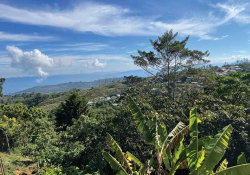Hauntings

ELIZABETH JOY SERRANO-QUIJANO’S stories are set in Matanao, Davao del Sur, a town in southeastern Philippines. She is part Blaan, an indigenous group known more generally as Lumad, a name for about twenty or so minority groups who have been historically dominated by colonizers, and now by Filipino settlers in Mindanao. Although this facet of Serrano-Quijano’s fiction is less prominent in “The Pregnant Woman from Zamboanga,” the story manifests tensions of place.
Cebuano has about sixteen million speakers, the second-most-spoken language in the country. Waves of migration from the Visayas brought the language to many parts of Mindanao. Serrano-Quijano’s Cebuano is the Mindanao variation, the register commonplace compared to the flashier style preferred by writers from Cebu and Bohol. But her colloquial language often lends itself to eloquence: “Manghod na sa gabii ang kolor sa palibot.” Roughly, the passage translates to “The surroundings took on the color of night’s younger sibling.” She casually uses English words that have made their way into everyday conversation: “Kay hapit na lagi ang closing” (Because the school’s closing [ceremony] was near). To native speakers, the borrowing rings familiar and true.
I knew that I’d be losing this texture from the start. I tried to stay close to Serrano-Quijano’s rhythm by following her own arrangement of words—or at least similar to the syntax in Cebuano. Her plainspoken but concise sentences keep this goal within reach. I decided to keep terms such as aswang—a ubiquitous, flesh-eating shapeshifter—and its fellow, the engkanto. In another story, Serrano-Quijano’s narrator talks about “ays krim” (ice cream) and “piktyur” (picture). These terms situate the reader in time and space: outsiders have come to this place, and they brought along some baggage. More than the way she uses language, I wanted to be faithful to what Serrano-Quijano is able to contain.
In “The Pregnant Woman from Zamboanga,” what begins as a standard tale about a haunting unfolds into a story about origins. The young narrator shares a story told to her by her grandfather: the ghost of a woman appears on the path along the stream. Of all her grandfather’s stories, this one has endured. It’s the story, not just of any woman, but a pregnant one who had come all the way from Zamboanga, nearly four hundred miles west of Matanao. It’s also the story of expansion; the roads to Matanao were being paved for the first time. The grandfather was among those who built the roads in the 1970s, the decade when the dictator Ferdinand Marcos ignited the Muslim separatist movement and civil war with Maoist rebels. Loyalists praise Marcos for having built edifices even to this day. Incidentally, the structures are haunted by stories of children sacrificed at the construction of a massive bridge or workers buried alive in a film center.
When I began to translate Serrano-Quijano’s work, I noticed how seemingly uniform the stories are in structure and length. Whether it’s a cautionary tale or a slice of life in a little-known town, a story runs a few hundred short of two thousand words. Read more closely, each of her stories reveals so much more. There are kindly and lonesome neighbors, delinquent husbands, vengeful wives, and a house barely standing in the monsoon. There are strangers capable of casting a curse with a tap on the shoulder. There is a grim story about insurgency, told by a young girl. They are unmistakably of their time and milieu—Mindanao, at present. Serrano-Quijano folds a complex political and social landscape into a ghost story and hints at a larger, more pervasive wickedness.
Editorial note: Read Bengan’s translation of “The Pregnant Woman from Zamboanga.”









